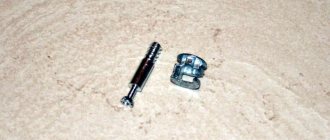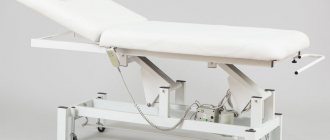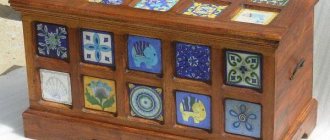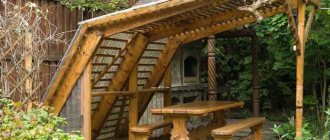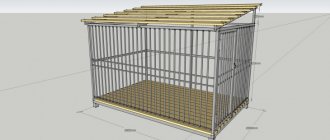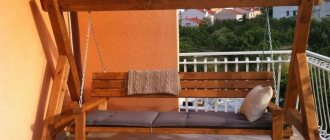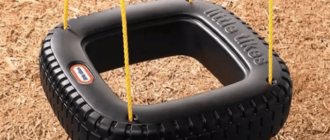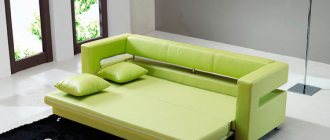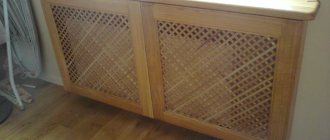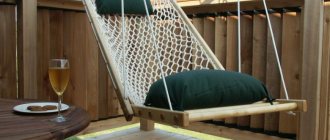Comfortable couch for a beauty salon
Often, couches are found in hospital waiting rooms and treatment rooms. But this is a universal piece of furniture that can be used in the countryside - complement it with side stands, throw a canopy on top - you will get a beautiful, cozy place for relaxing in nature.
Do-it-yourself outdoor couch in the country from pallets
In the kitchen, a couch will create additional seating, and if you equip it with shelves, there will be a place to store various kitchen utensils.
Kitchen couch with soft seat and extra storage space
In the hall, such furniture will be especially useful for people with back problems, because it’s not for nothing that doctors recommend that they rest on a hard surface.
Fashionable and stylish red couch in the living room
By showing your imagination, such a nondescript accessory can be turned into a real masterpiece. A DIY couch will fit perfectly into your interior and is not difficult to make.
Comfortable and practical DIY wooden couch
Depending on individual needs, location and available space, couches can be of different sizes: large, small, medium, straight and corner. They can be equipped with additional shelves or drawers, made with or without a back, covered with fabric or leatherette - such a piece of furniture will not go unnoticed and will be your pride.
Small sofa-couch, do-it-yourself for the living room
How to make a couch with your own hands: the easiest way
- Methods of application
- Varieties
- Benefits of homemade couches
- Do it yourself
- Step by step guide
Hi all!
There is an opinion that couches are exclusively furnished in hospitals and treatment rooms. This is a misconception. In fact, we are talking about a very versatile design that can be used for various purposes. And the assembled couch with your own hands is not as complicated as some people think. Depending on what goals you are pursuing, you can make or buy the appropriate version of the couch.
Today I will tell you about where they are used and for what. We will also discuss the assembly issue with you.
The main types of couch models:
A special mobile massage couch that allows you to adjust the height
- with or without an armrest;
- with and without backrest;
- on thin and thick legs;
- soft couches;
- completely covered with fabric or leather.
Backless couch with decorative bolsters
Drawing
To make a high-quality piece of furniture, you will need to make a preliminary drawing with a detailed designation of all sizes, number of parts and methods of fastening. It will depend on the availability of the drawing whether you will be able to make a couch with your own hands the first time or not .
You can make a drawing in different ways. Some prefer to draw it by hand on paper. But for this you need to be able to calculate dimensions and be able to draw up drawings. Others turn to specialized companies. They will not only make a detailed diagram, but also prepare all the details according to size. Someone finds a suitable option on the Internet and prepares furniture according to a sketch already made by someone.
Each individual option has its own advantages.
Why do it?
Not all people are interested in creating products with their own hands, because now everything can be bought in specialized stores. However, it should be taken into account: by doing something yourself, you can not only get the desired result, but also feel proud of your work. A hand-made couch can become the highlight of the interior and serve not only as a place to relax, but also as a decoration for the room.
When making furniture at home, the craftsman knows exactly about the quality of the materials used. Own production is much cheaper than purchasing goods in a store. It's very profitable.
How to make a couch with a bedside table yourself, see the following video.
Step-by-step instruction
- Before starting work, you need to prepare all the tools and materials that you will need to create high-quality furniture. Coniferous boards must have a flat and smooth surface and be the same size. All tools must be in good working order, and the cutting parts must first be sharpened.
- The production of parts begins with the side parts. The slats have spikes at their ends, so there must be special grooves in the center of the boards. Wooden spacers should have a length equal to the distance between the slats. Their thickness corresponds to the width of the groove, and their height corresponds to the depth of the groove. Before joining the parts, they need to be treated with glue.
- The parts must be of such dimensions that they will allow other components to fit in with some effort. Having assembled the sidewalls, they need to be pressed. After this, you should let them dry thoroughly.
- All four blanks are made according to the same principle. They dry for several hours. The joints of the boards should be located in the same plane.
- To make the legs, a template is used, according to which the necessary parts are cut out. The cut needs to be sanded and the edges slightly rounded. You can check the correctness of the cut legs by connecting them together and fitting them to one measurement.
- The back is made in the same way as the rest of the structure. However, it is important to remember that the upper parts are attached at a slight angle, and the lower slats must have a right angle slope. Having assembled all the parts of the structure and made sure that they are of high quality, you need to start attaching the metal elements. They are needed so that the product can be folded and unfolded.
- Typically, the couch is subject to heavy loads, so the places where the screws are attached need to be further strengthened. To do this, glue is poured into the holes and wooden dowels are inserted. After this, screw in the screws. This method of strengthening the structure guarantees a long “life” of the product.
Transformation mechanism
The extendable couch is very comfortable. The folded version looks compact, but if necessary it turns into a full-fledged sleeping place. The most common transformation mechanisms are:
- Click-clack. The elements located on the sides, when lowered to a horizontal position, create a bed of the required length. You can leave one side raised, then it will be comfortable to rest reclining on the couch.
- Dolphin. The side part moves to the side, revealing a hidden area. The berth increases in width due to a retractable element hidden under the seat.
- Sedaflex. The seat is removed to reveal a built-in structure, which, when folded out, is installed on supports. It turns out to be a more comfortable sleeping place.
- Eurobook. The seat surface extends to create free space. The backrest falls into it.
- Hemnes. The folded model is a miniature sofa where one person can sleep. By rolling out the block hidden under the seat, you get a spacious double bed. The product is complemented by spacious storage compartments located under the pull-out part.
Click-clack Dolphin
Eurobook Hemnes
Drawing
To make a high-quality piece of furniture, you will need to make a preliminary drawing with a detailed designation of all sizes, number of parts and methods of fastening. It will depend on the availability of the drawing whether you will be able to make a couch with your own hands the first time or not .
Attention : when making a couch, it is worth taking into account the dimensions of the future mattress. Experts recommend purchasing a mattress first, and then starting to draw up a drawing.
You can make a drawing in different ways. Some prefer to draw it by hand on paper. But for this you need to be able to calculate dimensions and be able to draw up drawings. Others turn to specialized companies. They will not only make a detailed diagram, but also prepare all the details according to size. Someone finds a suitable option on the Internet and prepares furniture according to a sketch already made by someone.
Dimensions
The size range of couches is not limited to any standards, so today there is no problem choosing an elegant option for a small room or a longer and wider couch for a spacious room. Among the most common and popular sizes of couches are 1750x650x620 mm, 1950x830x820 mm, 1410x800x760 mm, 1400x750x750 mm and other sizes. Folding sofas provide sleeping space in sizes 120x200 cm, 70x100 cm, 70x187 cm, as well as other options.
A small model is not suitable for accommodating a large number of people, and this is not necessary. Typically, such furniture is used in the hallway when you need to sit down to put on your shoes or answer a phone call.
The “baby” couch, despite its compact appearance, will be an excellent sleeping option for one person. This roll-out sofa will not take up much space, but will do the job assigned to it perfectly.
A narrow daybed will certainly be an excellent addition to the kitchen set. Small-sized kitchens (Khrushchev-era apartments) are so cramped that it is not always possible to place a standard set of furniture there. In this case, a miniature, narrow couch is exactly what you need.
How to make a massage option?
Before you start making a couch, it is recommended to prepare a drawing, tools and materials in advance. This will significantly shorten the furniture manufacturing process. The work order will look like this :
- First, parts for the side parts are made. The slats will have spikes at the ends. Therefore, small grooves are made in the center of the boards. When making wooden spacers, it is worth considering that their length should be equal to the distance between the slats . Before joining the parts, all places are carefully lubricated with furniture glue and screwed with self-tapping screws. This will significantly increase the strength of the structure.
- After assembling the sidewalls, the parts are left to dry completely.
Next we start making the legs. They are cut according to a pre-prepared template. The cuts on the legs are polished and the edges are rounded. To check how correctly the legs are cut, they are connected all together and adjusted to the same size .
- The back of the couch is made according to the same principle as the sides. But keep in mind, the top parts are located at an angle.
- After assembling all parts of the structure, the product is checked for quality of assembly.
- After this, we begin making slats for the mattress. When making lamellas, it is necessary to take into account that their length should be 30 cm, and their width can be any. There is a distance of 4 cm between the slats. They are secured at the ends with bars. And the bars are attached to the planks with self-tapping screws.
- After all the parts are made, they undergo careful processing: all elements are sanded, primed, and treated with antiseptics.
Warning : heavy loads will be placed on the couch. Therefore, all places where screws are attached are additionally reinforced with glue.
Blueprints
Before you start work, you need to decide what the structure will be and draw up a drawing of it. Before choosing the dimensions of the furniture, you need to decide where it will be installed and accurately measure the room. An important parameter is the size of the mattress that will be laid on the finished product.
If the design is planned to be retractable or folding, then you need to take into account how much space the ottoman will take up when unfolded. It is important to leave some extra space. For example, if the size of the mattress is 1400x2000 mm, then the dimensions of the frame should be 2-3 mm larger, which will allow the mattress to be conveniently placed in the base.
The ottoman bed is a simple design. This is a rectangular sleeping place that consists of a frame, bottom, legs and headboard. If desired, you can also model the side border, thus turning a simple ottoman into a corner one.
Having a drawing of the model and dimensions, it is necessary to develop an assembly diagram - the sequence of interconnection of structural elements. You can look at ready-made assembly diagrams for similar products and adapt them to your own.
Master class on self-production
Before making a massage table, you should prepare everything you need. To draw a drawing and measure parts, you need a pencil, tape measure and square. Depending on the material of manufacture, the following tools are also needed:
You will also need artificial leather and stuffing material. If the product will be used at home and not very intensively, then you can use foam rubber. Some models also use PVA wood glue.
Made of wood
For work you need plywood with a thickness of 0.9 cm and dimensions 60 x 90 cm - 2 sheets, a wooden beam (2 x 5 cm) - 18 m, artificial leather - 110 x 210 cm. You also need to purchase 14 loops 1.8 x 5 cm The manufacturing process includes the following stages:
- Creating a tabletop. At this stage, an oval hole measuring 18 x 12 cm is prepared for the face.
- Frame assembly. The dimensions of the frame and tabletop must match exactly. To connect the timber, self-tapping screws 4.5 cm long are used. Holes are pre-drilled for them. The tabletop is also fixed to the frame with self-tapping screws.
- Fastening the padding and covering the frame. The foam rubber is fixed using wood glue. The protruding parts are cut off with a stationery knife. The upholstery is attached using a construction stapler. The step between staples is 10 cm.
- Making legs. To do this, you will need 2 x 5 cm bars with a length of 85.5 cm. They are screwed to the frame and additionally secured with spacers at the bottom. You will need 2 of these designs.
If necessary, additional spacers along the length of the table can be fixed on the legs, which will make it more stable. The last step is finishing the structure: every visible wooden element should be varnished or painted. They should not have burrs.
Made of metal
Metal models are also not considered difficult to make yourself. You will need a steel or aluminum pipe of square or rectangular cross-section. Welding or screws (bolts and nuts) can be used for connection. You need to twist aluminum. The metal frame is cleaned, sanded and painted before the tabletop is attached. The work includes the following stages:
- Making the frame. The size of the metal profile depends on the dimensions of the tabletop: it should extend 5-10 cm beyond the supporting structure. The cross-section of the pipe is 2 x 4 cm. The frame requires 4 pieces, 2 of which are short and 2 are long. You also need a long cross member, which serves as a stiffening rib for the structure.
- Fixation of legs. They are installed strictly perpendicular to the frame in its corners. If it is necessary to adjust the height, holes are drilled on the legs, and then small pieces of metal profiles with the same holes are attached to them. The step between them is 1.5-2 cm.
- Tabletop installation. It can be wooden or metal. At this stage, the filling is laid and the upholstery is fixed.
Choosing material
Modern ottomans and couches are relatively simple designs, which makes it possible to make them yourself. To get high-quality and durable furniture, you should choose the right material for the product. Today, several types of products are used for such work:
- Laminated chipboard. The material is simple and low in price. You can purchase these products at almost any hardware store. The main disadvantages of chipboard are considered to be low strength and a minimum number of color options. It should also be noted that the structure of the slab contains harmful substances that can be released into the air.
- Furniture board. It is made only from natural materials, which reduces the presence of components harmful to humans. Furniture panels can be compared in strength to solid wood. One of the main disadvantages of such a product is its high price, which slows down its distribution in hardware stores.
- Array. Their natural board ottoman is strong and durable. If the size of the couch is small, then the array is the best option in terms of price and quality ratio.
Also, to build such furniture you will need a lot of auxiliary materials:
- Wooden beam. It is used to fasten joining parts. Sometimes horizontal struts or supporting surfaces are formed using a block.
- Finishing fabric. There are no universal recommendations here, since you can choose this product to suit your taste in any specialized store. Very often flock or chenille are used for this.
- Filler. Various types of foam rubber or padding polyester are used as this product.
- Additional accessories. They are used for decorative finishing of the ottoman. This may include special fasteners, threads for lining, buttons, etc.
Design Features
It is worth considering the main types of couches:
- the couch-ottoman has a rigid base with a removable solid mattress or flat pillows;
- ottoman couch - an analogue of the previous model, complemented by flat pillows for the back, moved to the wall;
- daybed-banquette - a narrowed and shortened model with a horizontal surface and small side arms-backs;
- a couch-canapé is an analogue of an ottoman with a raised headboard and a shaped incomplete back.
The list goes on, these are not all common or homemade modifications.
Important! For self-production, choose a model that will fit perfectly into the existing interior and complement it.
The main preparation consists of carefully processing the parts. All wooden surfaces (except those that will be covered) should be thoroughly sanded, stained (if necessary) and varnished.
A little trick: After the first layer of varnish, go through the sandpaper again. The raised wooden “hairs” under the varnish will harden, and you can easily get rid of them.
The foam rubber should be cut with a margin: we bend it under the bottom of the parts to protect the upholstery material from premature abrasion. The corners are soft and the fabric does not rub against the plywood. If you are new to upholstery, I will give you a couple of tips:
- First, shoot the tapestry in a “quiet state,” that is, untensioned, to any long side of the piece. Then you begin to pull and shoot from the middle of the opposite side to the edges. Repeat the same procedure along the short ends: From the middle to the edges.
- At the corners on the inside, cut off the “extra” material diagonally, simply placing the resulting fold perpendicular to the plane of the part.
What is it made of: wood or chipboard?
You can make a couch from different materials:
- boards;
- pallets;
- timber;
- MDF;
- Chipboard.
Everyone chooses the option that is most suitable for them.
Advice: experts recommend giving preference to natural wood. Exotic breeds are rarely used here because of their price.
Most often, inexpensive wood is chosen for the manufacture of couches:
- Birches. It is distinguished by its beautiful white shade, ease of processing, interesting texture, durability and resistance to negative factors.
- Pines. It has a beautiful shade and texture and is inexpensive. During its entire lifespan, needles emit a pleasant aroma that has a beneficial effect on human health.
- Linden trees. The material paints well, sands well and has a beautiful texture. Due to the softness of the wood, there should be no problems with cutting out parts.
How to make a couch with your own hands?
DIY wooden couch
Please note that all wooden elements must be sanded with sandpaper, painted, and then varnished. Therefore, immediately decide on the desired color of the future product. When the first layer of varnish has dried, you can sand the parts again - all the small chips sticking out will harden and will be easy to get rid of.
Wooden couch with a soft mattress and a lifting part for ease of procedures
If you want to give the product softness, use a universal and cheap material as a filler - foam rubber. Choose a medium level of hardness, since too soft will sag, and hard will cause discomfort. Cut the foam rubber a few centimeters more - it must be secured to the bottom of the parts to prevent premature wear of the upholstery.
Decorating the product
Unusual rope daybed-bed
For decoration, you can only use paints and varnishes, various synthetic ones, microfiber, dermantin or velor - it all depends on your taste and budget. Synthetic upholstery retains its color and shape for a long time, but it tends to electrify and attract dust.
Massage couch with wooden legs and soft upholstery
The couch will have an interesting appearance if you drill holes in the plywood and tighten the filler with nylon thread. The holes will be hidden with the help of beautiful buttons covered with matching fabric.
Using the couch for relaxation, massage and treatments
DIY couch in the hallway
I had long wanted to buy a couch for the hallway of my house, but none of the furniture stores had the appropriate sizes, so I made it myself.
You needed: foam rubber, padding polyester, furniture buttons, 10 cm needle, polyester thread, furniture fabric for upholstery, figured glued pine trim, 2 balusters, glue for foam rubber, white impregnation.
Base, couch frame
Using self-tapping screws, I assembled a rectangular base of the desired size from a wooden board with a cross-section of 10×2 cm. At the corners I attached legs - balusters cut in half. I treated everything with impregnation in one layer and let it dry. Then I made a seat: I applied glue to a furniture panel to match the size of the frame and glued a sheet of foam rubber 10 cm thick, with an allowance of 3-4 cm on each side. Left it until completely dry. I cut off the excess along the wooden base with a knife.
Correct marking and fastening of buttons
I drew a diamond-shaped outline onto the foam rubber with a pencil for attaching furniture buttons. Using a drill, I drilled through holes d 3 mm in the foam rubber and wooden base. Then, using a knife to remove the cores from apples, I cut holes 2 cm in diameter in the foam rubber in the marked places. I covered the future seat with padding polyester, stretching it slightly, and secured it to the base using a furniture stapler. Covered the top with cloth.
